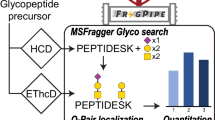Abstract
Discrimination of Lysosomal membrane proteins (LMP’s) from folding types of globular (GPs) and other membrane proteins (OtMPs) is an important task both for identifying LMPs from genomic sequences and for the successful prediction of their secondary and tertiary structures. We have systematically analyzed the amino acid frequencies as well as dipeptide count of GPs, LMPs and OtMPs. Based on the above calculated single amino acid frequency combined with dipeptide count information, we statistically discriminated LMPs from GPs and OtMPs. This approach correctly classified the LMPs with an accuracy of 95 %. On the other hand, the amino acid frequency alone can discriminate LMPs with an accuracy of only 79 %. Similarly dipeptide count alone has an accuracy of 87 % for the discrimination of LMPs. Thus the combined information of both amino acid frequencies and dipeptide composition gives us significant high accurate results.



Similar content being viewed by others
Abbreviations
- AA:
-
Amino acid
- LMPs:
-
Lysosome membrane proteins
- LSDs:
-
Lysosomal Storage Disorders
- GPs:
-
Globular proteins
- OtMPs:
-
Other membrane proteins
- PseAA:
-
Pseudo amino acid
- PDB:
-
Protein Databank
References
Ahmad S, Gromiha MM (2002) NETASA: neural network based prediction of solvent accessibility. Bioinformatics 18:819–824
Berman HM, Westbrook J, Feng Z, Gilliland G, Bhat TN, Weissig H, Shindyalov IN, Bourne PE (2000) The protein data bank. Nucleic Acids Res 28:235–242
Branden C, Tooze C (1999) Introduction to protein structure. Garland Publishing Inc., New York
Cai YD, Ricardo PW, Jen CH, Chou V (2004) Application of SVM to predict membrane protein types. J Theor Biol 226:373–376
Chou PY, Fasman GD (1978) Prediction of the secondary structure of proteins from their amino acid sequence. Adv Enzymol 47:45–148
Chou KC, Shen HB (2007) MemType-2L: a Web server for predicting membrane proteins and their types by incorporating evolution information through Pse-PSSM. Biochem Biophys Res Commun 360:339–345
Chou KC, Shen HB (2009) Review: recent advances in developing web-servers for predicting protein attributes. Nat Sci 2009(2):63–92
Cuff JA, Barton GJ (1999) Evaluation and improvement of multiple sequence methods for protein secondary structure prediction. Proteins 34:508–519
Gromiha MM, Suwa M (2005) A simple statistical method for discriminating outer membrane proteins with better accuracy. Bioinformatics 21(7):961–968
Gromiha MM, Ahmad S, Suwa M (2005) Application of residue distribution along the sequence for discriminating outer membrane proteins. Comput Biol Chem 29:135–142
Liu H, Wang M, Chou KC (2005) Low-frequency Fourier spectrum for predicting membrane protein types. Biochem Biophys Res Commun 336:737–739
Lomize MA, Lomize AL, Pogozheva ID, Mosberg HI (2006) OPM: orientations of Proteins in Membranes database. Bioinformatics 22:623–625
Pautsch A, Schulz GE (2000) High-resolution structure of the OmpA membrane domain. J Mol Biol 298:273–282
Sonnhammer ELL, Heijne GV and Krogh A (1998) A hidden Markov model for predicting transmembrane helices in protein sequences. In: Proceedings of Sixth International Conference on Intelligent Systems for Molecular Biology, AAAI/MIT Press: Menlo Park, CA. 6, 175–182
Tripathi V, Gupta D (2014) Discriminating lysosomal membrane protein types using dynamic neural network. J Biomol Struct Dyn 32(10):1575–1582
Vandeputte-Rutten L, Kramer RA, Kroon J, Dekker N, Egmond MR, Gros P (2001) Crystal structure of the outer membrane protease OmpT from Escherichia coli suggests a novel catalytic site. EMBO J 20:5033–5039
Wang M, Yang J, Liu GP, Xu ZJ, Chou KC (2004) Weighted-support vector machines for predicting membrane protein types based on pseudo amino acid composition. Protein Eng Des Sel 17:509–516
Wang SQ, Yang J, Chou KC (2006) Using stacking generalization to predict membrane protein types based on pseudo-amino acid. J Theor Biol 242:941–946
Zeth K, Diederichs K, Welte W, Engelhardt H (2000) Crystal structure of Omp32, the anion-selective porin from Comamonas acidovorans, in complex with a periplasmic peptide at 2.1 A resolution. Structure 8:981–992
Acknowledgments
VT and PT are thankful to University Grants Commission, New Delhi for a research fellowship. The work has been supported by a DBT-BIF Grant to DKG under its BTISNet scheme.
Conflict of interest
Not declared.
Author information
Authors and Affiliations
Corresponding author
Electronic supplementary material
Below is the link to the electronic supplementary material.
Rights and permissions
About this article
Cite this article
Tripathi, V., Tripathi, P. & Gupta, D. Statistical approach for lysosomal membrane proteins (LMPs) identification. Syst Synth Biol 8, 313–319 (2014). https://doi.org/10.1007/s11693-014-9153-7
Received:
Revised:
Accepted:
Published:
Issue Date:
DOI: https://doi.org/10.1007/s11693-014-9153-7




